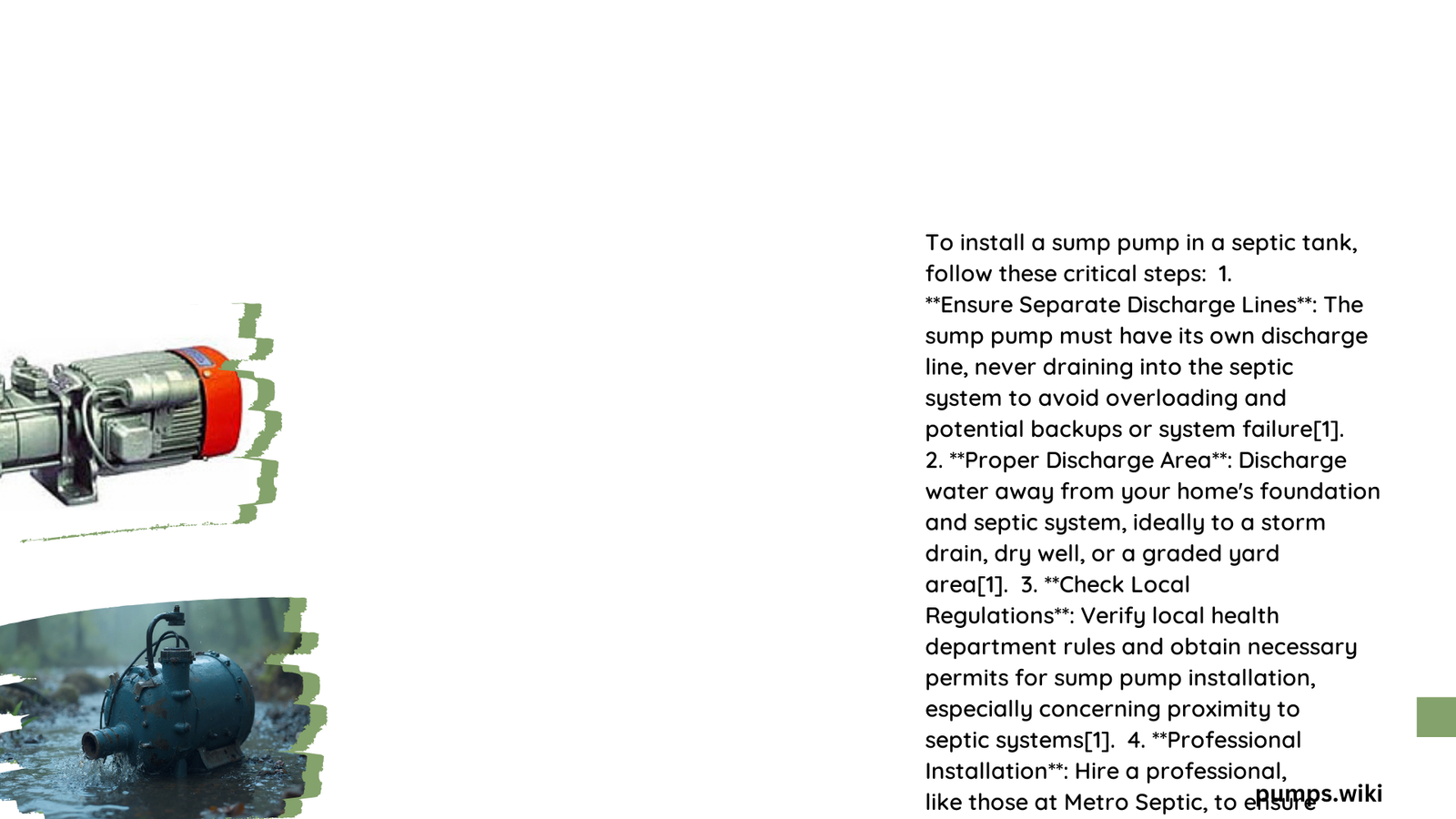Installing a sump pump in a septic tank is a crucial process for maintaining an efficient and long-lasting septic system. This guide provides step-by-step instructions, tool requirements, and important considerations for proper installation. From preparing the basin to testing the pump, we cover all aspects of sump pump installation in septic tanks, ensuring optimal performance and compliance with environmental regulations.
What Are the Key Steps for Installing a Sump Pump in a Septic Tank?
Installing a sump pump in a septic tank involves several critical steps:
- Prepare the septic tank or basin
- Install a new check valve
- Prepare the new pump
- Attach the adapter and pump to the discharge pipe
- Drill a weep hole
- Install the pump in the tank
- Test the pump and float switch
Let’s dive deeper into each of these steps:
1. How to Prepare the Septic Tank or Basin?
Before installing the sump pump, it’s crucial to ensure the septic tank or basin is ready:
- Remove any existing water and debris using a wet/dry vacuum if necessary
- Create a stable and level bottom if installing a new pump
- Ensure the tank is clean and free from any obstructions
2. Why is Installing a New Check Valve Important?
A new check valve is essential for proper pump operation:
- Disconnect the old pump and check valve
- Replace with a new check valve to prevent backflow
- Ensure the valve is compatible with your new pump and piping system
3. What Steps Are Involved in Preparing the New Pump?
Proper preparation of the new pump is crucial:
- Unbox the new pump and check valve
- Review the registration information and user manual
- Familiarize yourself with the pump’s features and specifications
4. How to Attach the Adapter and Pump to the Discharge Pipe?
Proper attachment is crucial for efficient pump operation:
- Apply PVC primer and cement to attach the male-threaded adapter to the PVC pipe
- Thread the adapter-end of the PVC pipe onto the pump
- Use a wrench to tighten, but be careful not to overtighten
5. Why is Drilling a Weep Hole Necessary?
A weep hole prevents air locking and ensures smooth pump operation:
- Drill a 3/16-inch hole in the pipeline between the pump and check valve
- Position the hole at a 45-degree angle, about 2 finger-widths above the adapter
6. What’s the Proper Method for Installing the Pump in the Tank?
Correct installation ensures optimal pump performance:
- Lower the pump into the septic tank
- Ensure it’s level and the float switch has enough space to move freely
- Secure the discharge pipe
- Properly manage the electrical cord to prevent tangling or damage
7. How to Test the Pump and Float Switch?
Testing is crucial to ensure proper functionality:
- Plug the pump into a dedicated circuit
- Activate the float switch to test the pump
- Verify that the pump turns on and off correctly
What Tools and Materials Are Needed for Installing a Sump Pump in a Septic Tank?

To successfully install a sump pump in a septic tank, you’ll need the following tools and materials:
| Tools | Materials |
|---|---|
| Drill with 3/16-inch bit | PVC primer and solvent |
| Tape measure | Sump pump check valve |
| Adjustable pipe wrench | PVC piping |
| Hack saw | Silicone sealant |
| Screwdrivers | Electrical wire grommet |
| Wet/dry vacuum | Grease-filled wire nuts |
| Adjustable pliers | Zip ties |
| Gloves | Rags or towels |
What Are the Compatibility Requirements for Sump Pumps in Septic Tanks?
When installing a sump pump in a septic tank, it’s crucial to consider compatibility:
Recommended Pump Types:
- Submersible sewage ejector pumps
- Effluent pumps
These pumps are specifically designed to handle the unique demands of septic systems.
Restrictions Based on Septic Tank Design:
- The pump must be compatible with the depth and volume of the septic tank
- For deep tanks, consider pumps with longer standpipes or float switches
- Ensure the pump’s flow rate matches the septic system’s requirements
What Are the Quantifiable Benefits of Installing a Sump Pump in Septic Systems?
Installing a sump pump in a septic system offers several measurable benefits:
- Efficiency Improvements:
- Ensures timely and controlled dosing of effluent
-
Reduces risk of system overload and failure
-
Cost Savings:
- Extends septic system lifespan (20-30 years vs. 10-15 years for poorly maintained systems)
-
Reduces frequency of repairs and replacements
-
Impact on System Longevity:
- Regular pumping maintains drainage field health
- Prevents clogging and ensures effective soil absorption
- Can add several years to the system’s lifespan
What Are the Viable Sump Pump Discharge Options for Septic Tanks?
Proper discharge is crucial for the effective operation of a sump pump in a septic tank:
Discharge Pipe Sizes and Distances:
- Typically use 1-2 inch PVC pipes
- Size according to pump’s flow rate and distance to drainage field
- Ensure even distribution across the field
- Position discharge pipe at least a few feet away from the house
Environmental Considerations and Regulations:
- Comply with local health and environmental regulations
- Prevent contamination of groundwater or surface water
- Use weep holes and proper venting to prevent air locking
By following these guidelines and considering all aspects of installation, you can ensure a properly functioning sump pump in your septic tank, leading to improved system efficiency and longevity.
References:
1. Sump Pump Installation Guide by Zoeller At Home
2. Sewage Ejector Pump Installation Guide by Sump Pumps Direct
3. Installing an Effluent Pump and Float Switches on a Septic System by Godinez Septics Inc.
